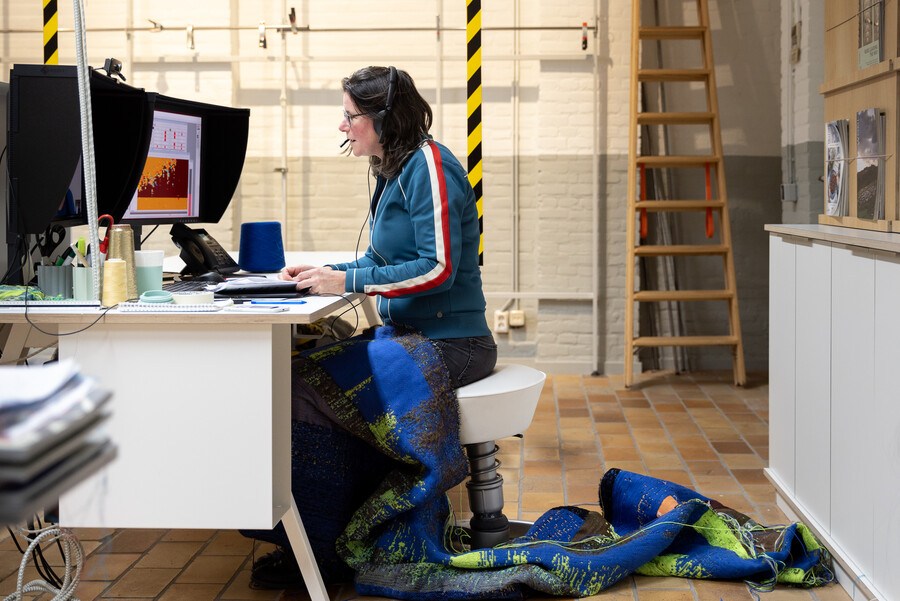How do you work in a workshop you can’t get to? The lab team developed a digital process that allows makers working from home to continue using the lab’s facilities. This isn’t only useful in a pandemic but also for makers who live far away. Like artist Mika Tajima, who worked remotely from New York with product developer Marjan van Oeffelt.
At an exhibition at the Cooper Hewitt Museum in her hometown of New York, Mika Tajima saw a piece by design studio Raw Color, stating that it had been made in the TextielLab in Tilburg. She discovered online that designers and artists can create experimental work here without being tied to the minimum purchase required by commercial weaving mills. She applied to weave three tapestries that form a new chapter in her ‘Negative Entropy’ project: a series of acoustic portraits that capture the sound of various production sites which exemplify technological shifts in society. These include high-tech data centres, high-quality machines and – in this case – advanced medical procedures. The three new tapestries visualise the sound of a Parkinson’s patient undergoing electrical brain stimulation, which is transmuted into a woven spectrogram image. Says Tajima: “It started as an abstract idea to capture a brain wave, but through contact with a neurosurgeon it gradually became something much more specific, which fits the current conception of productivity even better: an electrical pulse with which we can repair the human brain.”
Knowledge clips
“Normally, I would have come to the Netherlands for this project,” Tajima continues. When corona intervened, she took advantage of the opportunity to work remotely with the TextielLab. As it happened, the lab had used the lockdowns to install a new 3.5-metre-wide Dornier loom. “I loved being able to use it,” she says. “Of course, I would have loved to be present live at this magical production process, but I was also happy that we could get started together despite all the restrictions.” This was possible in part thanks to the digital development process the lab team had set up at lightning speed with support from the Mondriaan Fund. The foundations for working remotely were laid in the first two weeks of the pandemic during an outdoor brainstorming session, not only to get around the travel restrictions that were keeping people at home but also to meet the growing demand from international makers. There is now a digital Sample Studio, for example, where anyone can browse through samples from the lab. Knowledge clips were also produced for the various techniques. These short video tutorials explain the technical and creative aspects of the production process to help makers prepare for their development days.

Product developer Marjan van Oefelt in contact with Mika Tajima. Photo: Willeke Machiels
Hotline
The lab is also updating its hardware, to allow makers to watch the development of their work from any location. Improvements include colour-accurate screens, a high-resolution scanner that captures the smallest details and smart cameras that will be mounted on the looms this spring and can be operated remotely. For now, a lot can be done by telephone and via Teams, says product developer Marjan van Oeffelt. On the development days for ‘Negative Entropy’, she set up a hotline with the artist in New York from 1 pm. “We started by having online meetings, during which we exchanged examples. Because Mika was looking for more variety in the yarns, we also included a yarn advisor. We sent 20 yarns to New York so she could pick what she wanted. It was interesting that she also chose newly discovered yarns that I hadn’t yet woven with myself, such as a bouclé yarn, a very thin recycled polyester thread and a thick rope yarn with a brightly coloured core and knitted sheath.”
Reflection
When working remotely, the production process is split into various sessions, so that samples can be sent to the maker. “Instead of working intensely together in the lab for a week, we first did three development days, then another two days two weeks later and a final day two weeks after that. Besides all the photos and videos I sent daily, I also sent samples on three occasions via FedEx.” These intervals have their advantages, according to both Tajima and Van Oeffelt. “Instead of responding straight away and taking action immediately, I hung the samples on the wall here in my studio,” Tajima says. “That gave me an opportunity for reflection. I could talk about it with others and take the time to think about it. And while I was doing that, there was also time to order different yarns; I didn’t necessarily have to choose something that was in stock in the yarn collection.”
Depth
“Of course, it’s nice to be present in the lab as an artist, but in practice it turns out that you can have a lot of influence on the creative process from a distance,” says Van Oeffelt, who in consultation with Tajima made various adjustments during the process. “Weaving pixels is always tricky, and the wide loom seems to be more sensitive. The advantage of this modified process is that I was able to concentrate on elaborating the design. And even through Teams, you get to know each other.” Tajima is very pleased with the result: “I think it’s fantastic to see how a flat design gets so much depth by weaving it, and that the combination of machine, material and people leads to something so unique. You would expect machines to make standardised products, but that’s far from the truth at the TextielLab.”